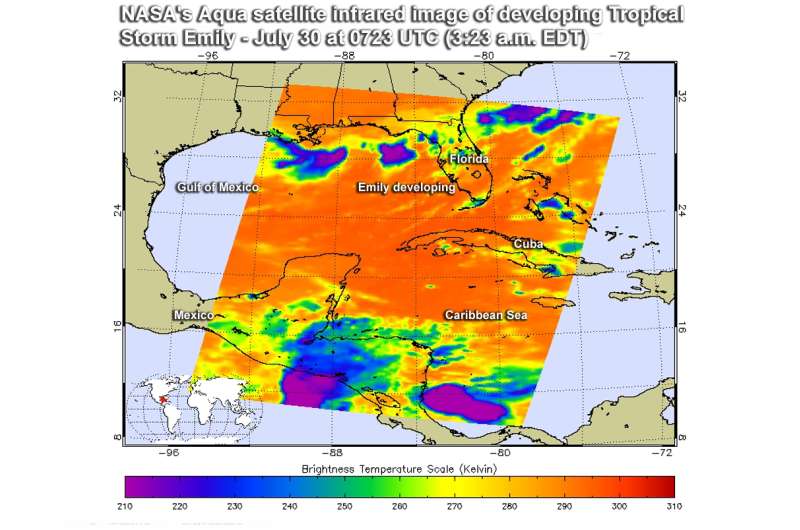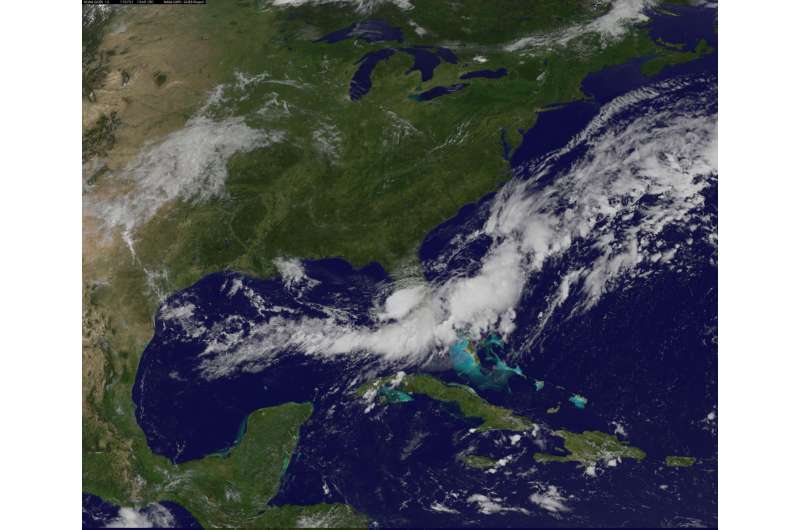NASA sees Tropical Storm Emily before and after landfall

NASA has captured infrared and visible imagery before and after Tropical Storm Emily formed in the Gulf of Mexico and made landfall in Florida.
On July 31, a Tropical Storm Warning was in effect for Anclote River to Bonita Beach, Florida.
The Atmospheric Infrared Sounder or AIRS instrument aboard NASA's Aqua satellite captured infrared data on the cloud top temperatures as Tropical Storm Emily was developing on July 30 at 0723 UTC (3:23 a.m. EDT) in the northeastern Gulf of Mexico along the Florida coast. The AIRS data showed a small area of strong thunderstorms with cloud top temperatures as cold as minus 63 degrees Fahrenheit (minus 53 degrees Celsius). NASA research has shown that storms with cloud tops that high in the troposphere have the potential to create heavy rainfall.
On July 31, that rainfall potential was part of the forecast from the National Hurricane Center (NHC). NHC noted that Emily is expected to produce total rain accumulations of 2 to 4 inches through Monday night along the west coast of central Florida between the Tampa Bay area and Naples, with isolated amounts up to 8 inches possible.
Tropical Depression Six formed on July 31 at 6 a.m. EDT near the west-central coast of Florida.

At 10:45 a.m. EDT on Monday, July 31, Tropical Storm Emily made landfall. The NHC said NOAA Doppler weather radar data and surface observations indicate that Tropical Storm Emily made landfall at 10:45 a.m. EDT (1445 UTC) on Anna Maria Island, just west of Bradenton, Florida.
The center of Tropical Storm Emily was located near 27.5 degrees north latitude and 82.7 degrees west longitude. Emily was moving toward the east near 9 mph (15 kph), and this general motion is expected to continue today. NHC forecasters said "a turn toward the northeast with an increase in forward speed are expected by tonight and Tuesday. On the forecast track, the center of Emily is expected to move inland over the the west-central Florida peninsula this afternoon, and move across central Florida through tonight. Emily is forecast to move offshore of the east-central Florida coast Tuesday morning."
Maximum sustained winds are near 45 mph (75 kph) with higher gusts. Little change in strength is forecast until landfall occurs this afternoon.
At 11:45 a.m. EDT (1545 UTC) NOAA's GOES-East satellite captured a visible image of Emily that showed the storm's center over the west coast of central Florida, with clouds extending to the Atlantic.
NOAA manages the GOES series of satellites. NASA/NOAA's GOES Project at NASA's Goddard Space Flight Center in Greenbelt, Maryland uses the satellite data to create imagery.
Emily is expected to weaken to a tropical depression while it moves across the Florida peninsula later today and tonight.
Provided by NASA's Goddard Space Flight Center




















